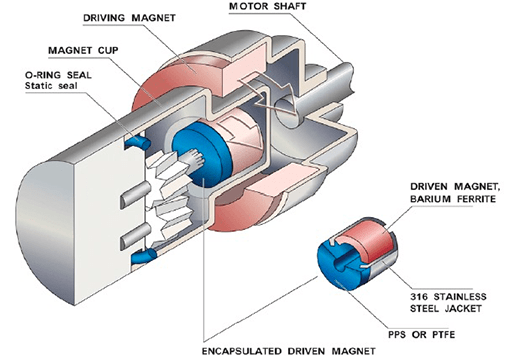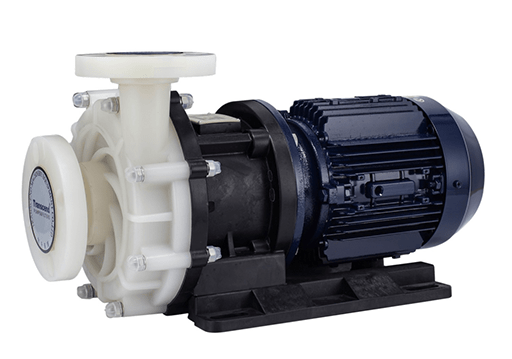
Figure 1: Magnet pump.
Magnet Pumps are seal-less centrifugal pumps that use a coaxial magnetic coupling to transmit torque to an impeller. They are energy efficient and can circulate a variety of fluids including acids, caustics, and oils. Magnetic drive pumps (like most seal-less pumps) have a higher capital cost than comparable centrifugal pumps, but offer reduced operating costs due to the lack of seal replacement, cleanup, waste, and downtime. They are particularly useful for transporting hazardous or expensive chemicals because there is no mechanical seal, eliminating the possibility of leakage or failure due to an obstruction.
1. Pump Operation and Classification
All pumps are designed to operate on either a dynamic or positive displacement principle. Dynamic pumps utilize fluid momentum and velocity to generate pump pressure while positive displacement pumps use expanding and contracting cavities to move fluids. Dynamic pumps produce a variable flow suited for generating high flow rates with low viscosity fluids, while positive displacement pumps produce a constant flow suited for producing high pressures (and low flow rates) with high viscosity fluids.
Magnetic drive pumps use magnets to generate movement. These magnets are mounted on a carrier or drive assembly and are driven by a standard electric motor. For dynamic pumps, this drive assembly typically moves an impeller; for positive displacement pumps, it moves a mechanism which expands and contracts a cavity. The drive assembly consists of two separate rings of permanent magnets. The outer set moves the inner set via a rotating magnetic field, which in turn drives the pumping mechanism.
This image shows a typical arrangement of the drive assembly in a rotating shaft magnet pump:

Figure 2: Drive assembly in a magnet pump.
This image shows a similar configuration, this one of a magnet gear pump:

Figure 3: A similar configuration of a magnet pump.
Most magnetic drive pumps are centrifugal pumps (a subset of dynamic pumps), although there are also positive displacement magnetic drive pumps (like the gear pump pictured above). Centrifugal pumps utilize one or more impellers to generate fluid velocity.
1.1 Types
There are two basic types of magnetic drive pumps: rotating shaft and stationary shaft.
Rotating shaft magnetic drive pumps are designed for heavy-duty applications. They are usually made of metal, which provides the best strength, temperature, and pressure ratings. The rotating shaft increases the complexity of the pump, meaning more parts are required. More parts means more maintenance and higher costs.

Figure 4: Rotating shaft magnetic drive pump.
Stationary shaft magnetic drive pumps have fixed shafts and the driven magnets move an entire are designed for light to medium-duty applications. They are usually made of non-metallic components (such as ceramics and plastics) which generally provide good corrosion resistance but have a limited temperature range up to 200-250°F. The stationary shaft decreases the complexity of the pump, meaning less parts are required, simplifying maintenance and reducing cost.

Figure 5: Stationary shaft magnetic drive pump.
2. Application Considerations
When considering using magnetic drive pumps for a particular application, there are a number of factors specific to these pumps that should be considered.
2.1 Pump Bearings
Conventional pumps, bearings are typically located away from the pumped media and are lubricated with other materials. Conversely, the bearings on the impeller shaft of magnetic drive pumps are lubricated by the pumpage itself. Therefore low flow, dry running, suspended solids, or media with poor lubrication qualities all can affect the reliability and lifetime of these bearings, and should be taken into account when considering this type of pump.
2.2 Operating Temperatures and Overheating
The magnets in a magnetic drive pump can demagnetize if exposed to temperatures above their upper limit. To avoid failure during high temperature applications, users should avoid dry running and other conditions that could cause unaccounted or unnecessary heat gain within the pump.
2.3 Decoupling
Magnet pumps are rated for a maximum torque. Beyond this point the magnets operate at reduced speeds; a state known as "decoupling". Operation in this state can permanently demagnetized the magnets, making these pumps especially vulnerable to variable operating conditions resulting in high power demands. To prevent decoupling, power monitors should be used for most applications involving magnetic drive pumps.
Related Info
What is a Magnet Pump?Types of Check Valve
How to Install a Sump Pump Check Valve: 5 Steps
How To Repair a Pool Spring Flapper Check Valve?


